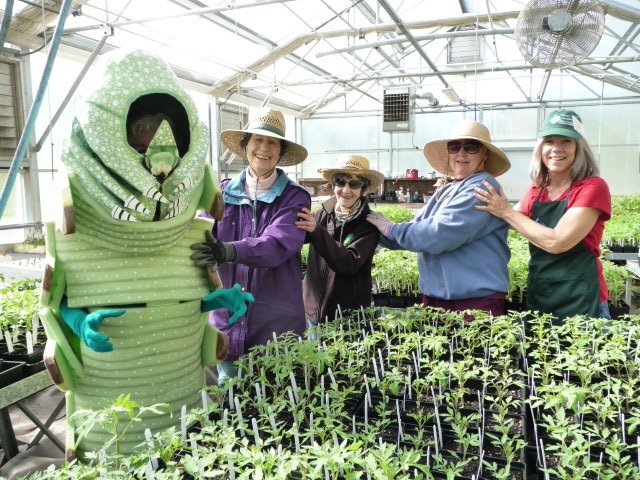 Are you growing tomatoes this year? Even though I am cutting back on some planting this summer to conserve water, tomatoes will continue to have a starring role in my garden. Here are a few pointers to help ensure your tomato success.
Are you growing tomatoes this year? Even though I am cutting back on some planting this summer to conserve water, tomatoes will continue to have a starring role in my garden. Here are a few pointers to help ensure your tomato success.
First, don't rush to get those tomatoes in the ground. Wait until the danger of frost is past and the soil is sufficiently warm (at least 60°F). Prior to planting, be sure to “harden off” the plants by keeping them outside for about a week. Place them in a sheltered location initially, then gradually expose them to your garden's conditions. If frost threatens, bring the plants indoors.
If you are purchasing tomato plants, choose stocky seedlings with healthy green leaves. The plants should not be root bound. Evaluate possible locations before deciding where to plant. To prevent soil-borne diseases from getting established, practice crop rotation. Do not plant tomatoes or other members of the nightshade family (potatoes, eggplants and peppers) in the same location more than two years in a row. If you plant tomatoes in pots, use new potting mix. Choose a location with full sun.
Your plants will be more productive if given plenty of room to grow. If you are planting caged or staked tomato plants, space therows 30 to 42 inches apart, leaving 24 to 30 inches between plants. If the plants are not staked or caged, plant them farther apart. If you use pots, choose large ones.
Water the seedlings and the planting area a few hours before planting. Pinch off all but the top two sets of leaves, then bury the seedling deeply, so that only the leaves and a little stem are above ground. Avoid handling the stem as new roots will form along the buried portion. If the plants are in biodegradable pots, break up the pots slightly so the roots can easily find the soil. Bury the pots completely to avoid water wicking away from the roots. If the seedlings are in plastic pots, gently remove the plants and loosen the roots. Press the soil firmly around the plant and water thoroughly.
Most tomato plants benefit from some type of support. Cages or stakes keep the tomatoes off the ground, conserve garden space and make harvest easier. I prefer cages and use the collapsible type that I can store easily over the winter. Place cages around tomatoes soon after planting to avoid damaging the plants later. With most cages, it's a good idea to place two strong stakes on both sides to provide support when the plant becomes heavy with fruit. Check the ultimate height of the tomato variety to determine the height of the cage required. The openings in the cage should be large enough for you to reach in and harvest fruit.
Alternatively, you can stake tomato plants. Select stakes six feet long and one and one-half inches to two inches wide. Drive them one foot into the soil,four to six inches from the plant. As the plants grow, pull the stems toward the stakes and loosely tie them to the stakes at intervals of 10 to 12 inches. Use a flexible material such as gardener's tape or fabric strips. Prune to a few main stems to keep the plants from becoming too heavy.
Tomatoes need regular irrigation. Extreme variation in soil moisture can promote fruit cracking and blossom-end rot. Keep the area weeded to prevent competition for nutrients and water and to eliminate habitat for pests. Place a three- to four-inch layer of mulch over the soil to reduce weeds and conserve moisture.
Feed with nitrogen when the plants flower, then every four to six weeks, following label instructions. Water thoroughly after fertilizing.
Harvest when tomatoesdevelop their full color. If you're like me, you can hardly wait for that first delicious bite.
Tomato Plant Sale: Napa County Master Gardeners will hold their second annual “Tomato Plant Sale and Education Day” on Saturday, April 19, in the South Oxbow parking lot on First Street in Napa. The sale will be held from 9:00 a.m. until sold out. All the seedlings have been started from seed and grown by Napa County Master Gardeners. At least 50 varieties of heirloom and hybrid tomato plants will be available. Master Gardeners will staff information tables on tomato support structures, common tomato pests and diseases, composting, good bug/bad bug displays and a mobile help desk. For a list of available tomato varieties, visit http://ucanr.org/ucmgnapa or call the Help Desk (hours below).
Master Gardeners are volunteers who help the University of California reach the gardening public with home gardening information. Napa County Master Gardeners ( http://ucanr.org/ucmgnapa/) are available to answer gardening questions in person or by phone, Monday, Wednesday and Friday, 9 a.m. to Noon, at the U. C. Cooperative Extension office, 1710 Soscol Avenue, Suite 4, Napa, 707-253-4143, or from outside City of Napa toll-free at 877-279-3065. Or e-mail your garden questions by following the guidelines on our web site. Click on Napa, then on Have Garden Questions? Find us on Facebook under UC Master Gardeners of Napa County.
Napa County Master Gardeners welcome the public to visit their demonstration garden at Connolly Ranch on Thursdays, from 10:00 a.m. until noon, except the last Thursday of the month. Connolly Ranch is at 3141 Browns Valley Road at Thompson Avenue in Napa. Enter on Thompson.